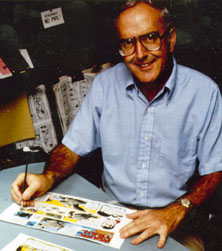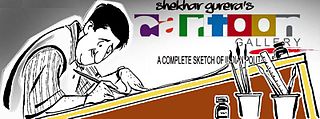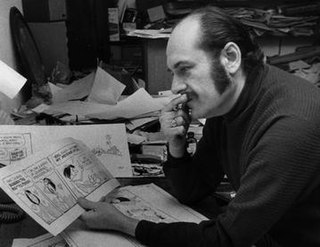Related Research Articles

A comic strip is a sequence of cartoons, arranged in interrelated panels to display brief humor or form a narrative, often serialized, with text in balloons and captions. Traditionally, throughout the 20th and into the 21st century, these have been published in newspapers and magazines, with daily horizontal strips printed in black-and-white in newspapers, while Sunday papers offered longer sequences in special color comics sections. With the advent of the internet, online comic strips began to appear as webcomics.

A cartoon is a type of visual art that is typically drawn, frequently animated, in an unrealistic or semi-realistic style. The specific meaning has evolved, but the modern usage usually refers to either: an image or series of images intended for satire, caricature, or humor; or a motion picture that relies on a sequence of illustrations for its animation. Someone who creates cartoons in the first sense is called a cartoonist, and in the second sense they are usually called an animator.
Webcomics are comics published on the internet, such as on a website or a mobile app. While many webcomics are published exclusively online, others are also published in magazines, newspapers, or comic books.

A cartoonist is a visual artist who specializes in both drawing and writing cartoons or comics. Cartoonists differ from comics writers or comics illustrators/artists in that they produce both the literary and graphic components of the work as part of their practice.

An editorial cartoonist, also known as a political cartoonist, is an artist who draws editorial cartoons that contain some level of political or social commentary. Their cartoons are used to convey and question an aspect of daily news or current affairs in a national or international context. Political cartoonists generally adopt a caricaturist style of drawing, to capture the likeness of a politician or subject. They may also employ humor or satire to ridicule an individual or group, emphasize their point of view or comment on a particular event.

King Features Syndicate, Inc. is an American content distribution and animation studio, consumer product licensing and print syndication company owned by Hearst Communications that distributes about 150 comic strips, newspaper columns, editorial cartoons, puzzles, and games to nearly 5,000 newspapers worldwide. King Features Syndicate also produces intellectual properties, develops new content and franchises, like The Cuphead Show!, which it produced with Netflix, and licenses its classic characters and properties.
James Mark Borgman is an American cartoonist. He is known for his political cartoons and his nationally syndicated comic strip Zits. He was the editorial cartoonist at The Cincinnati Enquirer from 1976 to 2008.

Doctor Fun is a single-panel, gag webcomic by David Farley. It began in September 1993, making it one of the earliest webcomics, and ran until June 2006. Doctor Fun was part of United Media's website from 1995, but had parted ways by 2003. The comic was one of the longest-running webcomics before it concluded, having run for nearly thirteen years with over 2,600 strips. The webcomic has been compared to The Far Side.

David Wiley Miller is an American cartoonist whose work is characterized by wry wit and trenchant social satire, is best known for his comic strip Non Sequitur, which he signs Wiley. Non Sequitur is the only cartoon to win National Cartoonists Society Divisional Awards in both the comic strip and comic panel categories, and Miller is the only cartoonist to win an NCS Divisional Award in his first year of syndication.
Notable events of 1935 in comics.

Jerry Scott is an American cartoonist and writer. He is known for co-creating the comic strips Baby Blues and Zits. He is one of only four cartoonists to have multiple strips appearing in over 1,000 newspapers worldwide.
Universal Press Syndicate (UPS), a subsidiary of Andrews McMeel Universal, was an independent press syndicate. It distributed lifestyle and opinion columns, comic strips and other content. Popular columns include Dear Abby, Ann Coulter, Roger Ebert and News of the Weird. Founded in 1970, it was merged in July 2009 with Uclick to form Universal Uclick.
Berry's World was the title of a syndicated daily editorial cartoon by Jim Berry which ran from February 18, 1963, through March 1, 2003, with a weekly color installment that appeared in the Sunday comic strip section. Berry received the National Cartoonist Society Newspaper Panel Cartoon Award for 1965, 1966, and 1972 for his work on the strip.

Howard Post was an American animator, cartoonist, and comic strip and comic book writer-artist.
Compu-toon is a comic strip by Charles Boyce.
A comic strip syndicate functions as an agent for cartoonists and comic strip creators, placing the cartoons and strips in as many newspapers as possible on behalf of the artist. A syndicate can annually receive thousands of submissions, from which only two or three might be selected for representation. In some cases, the work will be owned by the syndicate as opposed to the creator. The Guinness World Record for the world's most syndicated strip belongs to Jim Davis' Garfield, which at that point (2002) appeared in 2,570 newspapers, with 263 million readers worldwide.

Ferdinand Johnson, usually cited as Ferd Johnson, was an American cartoonist, best known for his 68-year stint on the Moon Mullins comic strip.
In the comic-strip field, a zombie strip is one whose creator has died or retired, but which continues to exist with new editions in publication. The strips are taken over by others, often relatives of the originator. Zombie comic strips are often criticized as lacking the "spark" that originally made the strip successful.
Quincy is an American syndicated newspaper comic strip published from July 13, 1970 to October 4, 1986, created and produced by cartoonist Ted Shearer. The series, about an African-American boy being raised by his grandmother in Harlem, was one of the earliest mainstream comic strips to star an African American in the lead role, following Dateline: Danger! (1968-1974) and Luther (1969-1986). Another predecessor, Wee Pals, features an African-American among an ensemble cast of different races and ethnicities.
References
- ↑ Richard Holeton (January 1998). Composing Cyberspace: Identity, Community, and Knowledge in the Electronic Age . McGraw-Hill. ISBN 978-0-07-029548-3.
- ↑ Allan Holtz (2012). American Newspaper Comics: An Encyclopedic Reference Guide. University of Michigan Press. pp. 111–. ISBN 978-0-472-11756-7.
- ↑ "BHM: Meet Charles Boyce" . Retrieved 21 September 2017.
- ↑ Laporte, Leo (25 May 2006). Techtv: Leo Laportes 2003 Technology Almanac. Pearson Education, Limited. ISBN 9780789728470 . Retrieved 21 September 2017– via Google Books.
- ↑ "'KeyPad Kid' Feature Now Part of 'Compu-toon' Comic – Editor & Publisher". www.editorandpublisher.com. Archived from the original on 22 September 2017. Retrieved 21 September 2017.
- ↑ "Charles Boyce" . Retrieved 21 September 2017.
- ↑ "Lake County Journal from Grayslake, Illinois on February 6, 2014 · Page 4". 6 February 2014. Retrieved 21 September 2017.
- ↑ "Tribune Media Services International | Byline". Archived from the original on 2004-12-04. Retrieved 2008-06-09.
- ↑ Insprucker, Mary Jekielek. "Barrington Man's Cartooning Will make You Laugh." Daily Herald Correspondent, 1 Jan 10 2007.
- ↑ Astor, David. "Diversity Push Makes the Comics a Little Less White." Editor & Publisher 131.49. 5 December 1998, p. 34-5. Accessed 1 Nov. 2017.
- ↑ Wiltz, Teresa. "STYLE & CULTURE; Cartoonist Group Sees Red; Eleven Minority-Drawn Strips Unite Sunday to Protest 'Tokenism' by the Media." Los Angeles Times, 08 Feb 2008.